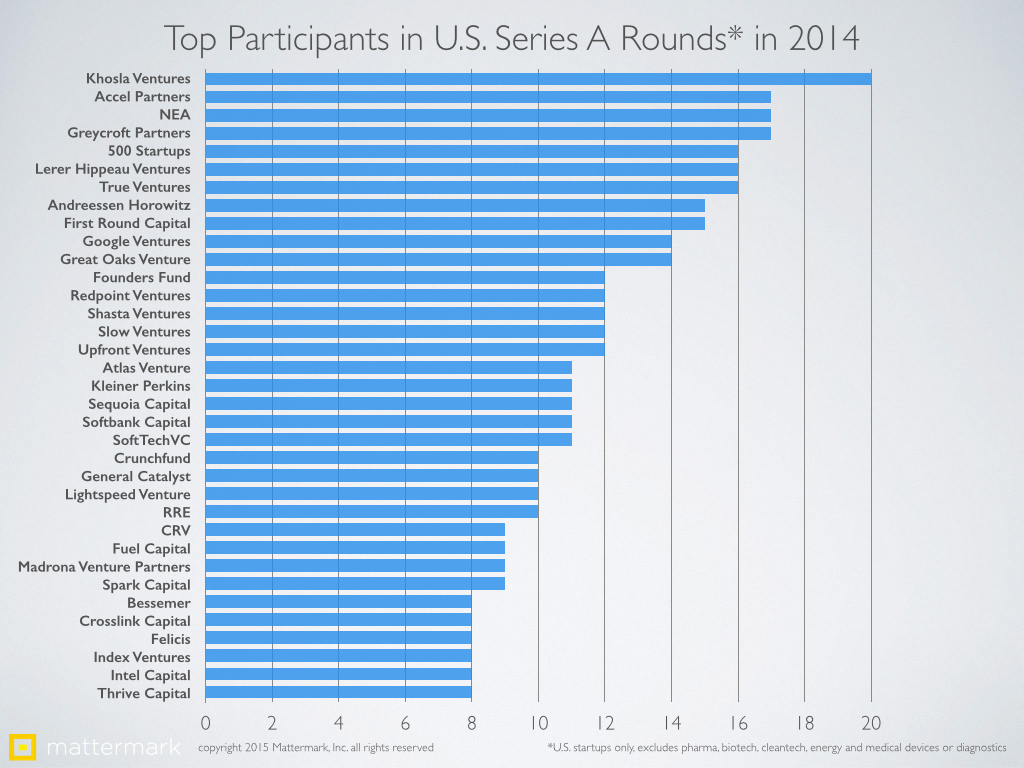 2014 is in the books, and the year saw interesting shifts in the early stage investing landscape. 701 Internet technology startups received a cumulative $5.1 Billion in Series A funding.
2014 is in the books, and the year saw interesting shifts in the early stage investing landscape. 701 Internet technology startups received a cumulative $5.1 Billion in Series A funding.
A few caveats before we get started: these rankings do not include investments in biotechnology, clean tech, energy, pharmaceuticals, medical devices or diagnostics. It is also worth noting that we have not re-categorized large seed rounds as Series A rounds despite the fact that many of them are now lead by institutional investors.
Top 10 Most Active U.S. Series A Investors in 2014
- Khosla Ventures
- Accel Partners
- New Enterprise Associates
- Greycroft Partners
- 500 Startups
- Lerer Hippeau Ventures
- True Ventures
- Andreessen Horowitz
- First Round Capital
- Google Ventures
One of the biggest surprises is that Khosla Ventures has moved into the #1 spot for most active Series A investor, with 20 deals completed in 2014 – up 25% from 15 Series A investments in 2013. The firm is reportedly raising a new $400M fund as we speak.
While not all of these investors are leading all of these Series A rounds, it is likely Khosla has been leading or co-leading most of theirs. As for other investors, founders can use this list to think through which seed backers are most likely to come in on their Series A deals and help companies raise subsequent funding.
It is also worth noting that this ranking has not been weighed for fund size, so naturally you can expect some investors simply will not be able to allocate the money or board seat time to as many new companies in a given year.
Embracing Risk: Lessons Learned from the 1980s
With these considerations in mind, these firms represent that most active risk takers in the United States startup investing ecosystem. In Jerry Neumann’s excellent essay “Heat Death: Venture Capital in the 1980s” he encourages us to look for patterns beyond the seemingly obvious 90s DotCom bubble, to gain broader perspective on the cycles of venture capital that came before. It is a fascinating and well-researched piece, which I hope you will read. The most important take-away is summarized at the end of the piece:
People in the VC industry talk about the ’60s, when institutional venture capital took off. They talk about the ’70s, when iconic companies like Apple and Genentech were founded and the microcomputer industry emerged. They talk about the ’90s and the Internet bubble. They don’t talk about the ’80s; the ’80s are the missing piece of the puzzle. You can have lots of plausible theories about what venture capitalists as a class can do to get good returns, until you take the 1980s into account. Then you can only have one: the only thing VCs can control that will improve their outcomes is having enough guts to bet on markets that don’t yet exist. Everything else is noise.
The 1990s are not our map, the 1980s are. Don’t worry about irrational exuberance fueling a bubble, that is not what is happening. Worry about fear of risk. We know where that leads: once again straight into the ditch.
This list of active Series A investors carries the torch for bravery in the face of fear, risk-taking even as those around them cash in on quicker and less risky returns on capital in the later stages. Here at Mattermark we can’t wait to observe and report on what 2015 brings.
To learn more about venture capital activity, startups and the international ecosystem of private companies we invite you to try our research platform. Access raw data and analysis through Mattermark Professional, including profiles of more than 1 million of the fastest growing technology companies worldwide. Sign up for a free trial today to get started.
Corrections and additions to this article may be submitted to editor@10.147.21.165
